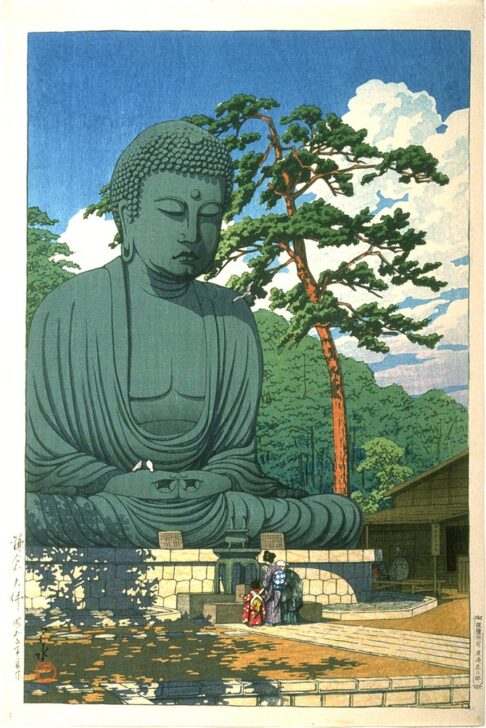The Daibutsu (Great Buddha) at Kamakura
Kawase Hasui

Description
Kawase Hasui and Takahashi Hiroaki both worked in concert with the prolific twentieth century publisher of woodblock prints Watanabe Shôzaburô (1885-1962). Their poetic and often times nostalgic landscape prints, very much following Edo period print master Andô Hiroshige’s foot prints (whose works are also shown in the gallery), have been highly sought after by collectors in Europe and North America.
Kawase Hasui was especially known for his skillful depiction of landscapes and night scenes. His passion for landscapes led him to travel extensively throughout Japan, keeping a sensitive eye on his surroundings and sketching scenes from his journeys. His close attention to atmospheric conditions and light brought him much success and one year before his death Kawase was awarded the great honor of Living Cultural Treasure for his 1956 print “Snow at Zôjôji Temple.”
Takahashi was trained in Japanese style painting (Nihonga), and dedicated much of his time to creating paintings for exhibitions as well as illustrations for scientific publications. While Kawase’s prints focus on notable places and landscapes, Takahashi’s work attempts to capture the essence of Japanese culture and everyday life.
exhibited summer 2010
The Great Buddha at Kamakura is over 37 feet tall and cast in bronze. Manufactured in 1253 during the Kamakura period (1185-1333), it is one of the largest Buddhist images, known for its colossal size and powerful realism. The artist’s Western influence is manifested by the inclusion of the colorful shadow of the tree across the Buddha’s seat and surrounding ground.
(Japanese Gallery Rotation, Spring 2010)
*Gallery Rotation Winter 2011 (January 2011
Kawase Hasui
Japan, 1883–1957
The Daibutsu (Great Buddha) at Kamakura
1930
Showa Period (1926–89)
Color woodblock print on paper
Museum purchase made possible by the Margaret Watson Parker Art Collection Fund, 1982/1.203
Subject Matter:
Kawase Hasui worked in concert with the prolific twentieth century publisher of woodblock prints Watanabe Shôzaburo (1885-1962).
Kawase Hasui was especially known for his skillful depiction of landscapes and night scenes. His passion for landscapes led him to travel extensively throughout Japan, keeping a sensitive eye on his surroundings and sketching scenes from his journeys. His close attention to atmospheric conditions and light brought him much success and one year before his death Kawase was awarded the great honor of Intangible Cultural Treasure for his 1956 print “Snow at Zôjôji Temple.”
Physical Description:
The daibutsu, or giant buddha, statue takes up the bulk of the pictorial space. Curving upwards and towards the statue is a large pine. At the feet of the green hued daibutsu statue are three women of different generations: a young girl, an adult woman, and an elderly woman. Although a few clouds hover in the sky, the sun appears to be shining brightly, casting some shadows of nearby trees into the picture.
Usage Rights:
If you are interested in using an image for a publication, please visit https://umma.umich.edu/request-image/ for more information and to fill out the online Image Rights and Reproductions Request Form.